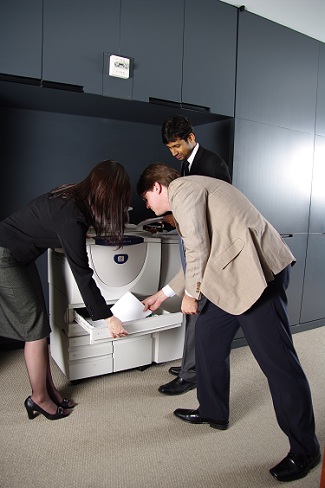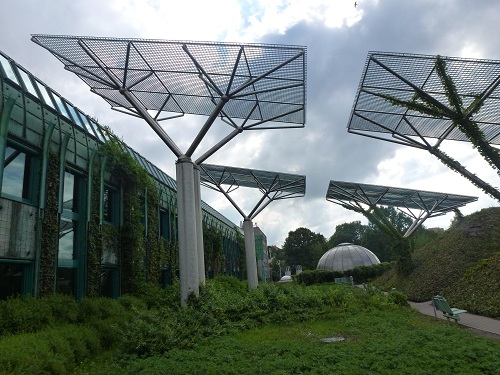Building the Efficient Office
How can office buildings eliminate electric bills?
The idea of running a business without an electric bill is sure to draw doubt. In fact, it sounds a little crazy. However, with energy costs rising, natural resources disappearing, and concern about climate change increasing, what may sound like science fiction is a growing trend in office buildings (and in residential neighborhoods in the near future).

According to the U.S. Energy Information Administration, office buildings are responsible for 19% of all commercial energy consumption, the most of all types of buildings. The cost for this is approximately $15.8 billion per year, the majority of which goes to electricity. Energy costs at this magnitude, along with a continued push to reduce the carbon footprint, have supported a rise in popularity of green buildings and, now, net-zero or zero-energy buildings.
Net-zero energy consumption is based upon the premise that a building can generate as much energy as it uses, therefore requiring no electricity from the electric grid. Additionally, any excess energy produced by an office building can be fed into the grid. Both the cost savings and environmental benefits are perpetuating this trend, and it is being applied in both new construction and in existing buildings with impressive results. Construction began in April on La Jolla Commons in San Diego, California, which upon completion will be the United States' largest net-zero office building, featuring 13 stories and 415,000 sq. ft.
What actually allows a building to generate as much energy as it uses? It is a combination of intelligent design and construction, innovative technology, and conscientious workers looking to pull away from the electric grid.
Design and Construction
Designing and building an office with net-zero energy consumption begins with a more efficient and sometimes unique layout. Open floor plans help prevent hot and cold pockets, and these buildings boast thicker walls, more insulation, and low-emittance coatings on windows, which aim to reduce the energy that is expended heating and cooling the inside. An emphasis on more windows in these types of buildings minimizes the need for artificial lighting, and advanced technologies, like geothermal systems and radiant heating, cut down on energy requirements for heating and cooling. Geothermal systems can be used to cool the buildings in the summer and heat them in the winter by using ground temperatures, and radiant heating can be installed in the floor to further energy savings.
Solar Energy Generation
A solar photovoltaic system provides the energy that fuels net-zero buildings and everything in them. Depending on the size of the building and its site, the solar panel system can line the rooftop or populate a field in a solar array aimed at generating massive amounts of energy. In locations with a shortfall of solar energy, buildings will tap into traditional energy sources, although the impact can be minimized by using a "smart" electrical system. However, when excess energy is produced by a building, it can be sent to the grid, essentially "paying back" any electricity that was used. Solar water heaters serve a similar purpose and are used to complement traditional water heaters. Solar thermal panels harness heat that warms the water in a reservoir and fills the tank to replace water used for sinks or baths.
Recycled Water
For office buildings with lawns, fountains, or other water needs, net-zero buildings turn water from aquifers and rainwater into usable water. This allows the buildings to capture and conserve water, without taking it from the water supply.
Energy-Efficient Appliances and Equipment
To earn a place in the break rooms and kitchens of net-zero office buildings, appliances must be extremely efficient and require less energy to function than traditional appliances do. Refrigerators, dishwashers, microwaves ... you name it, today's technology results in the most energy-efficient appliances ever. Increased sharing of office equipment, such as printers, further decreases the amount of energy required to keep an office operating at full-tilt.
Conscientious Residents
Even the most efficient buildings can use unnecessary energy, so once all of the pieces are in place to produce and conserve energy, the onus is on those who work there to be conscientious about the energy that they use. They must turn off appliances and lights when not in use and make sure that windows and doors are shut tightly.
It is easy to assume that such intensive efforts to reduce energy consumption are expensive propositions, and it is true that they have been. However, advances in technology and growing environmental consciousness are finally making green living easy and affordable. Not only are net-zero office buildings rising in popularity and growing in number, but net-zero energy homes are on the horizon. It may not be long before electric bills become a thing of the past, and offices and homes are fully capable of operating "off the grid."


Brent Hardy
Brent Hardy is the driving force for Extra Space Storage corporate responsibility through energy management and sustainability programs at www.extraspace.com. Brent leads a conversation about sustainability at blog.extraspace.com/category/sustainability.






